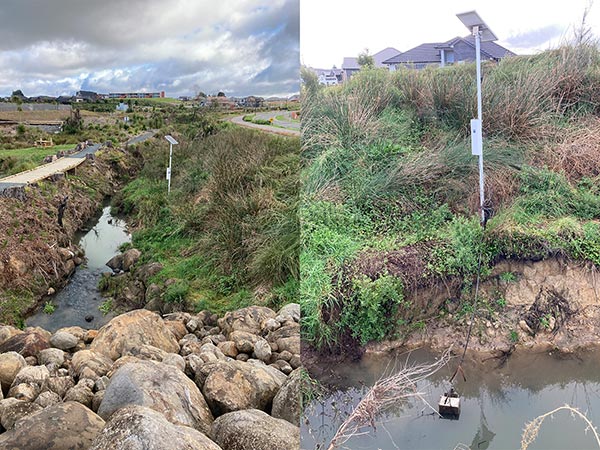Total Suspended Solids & Effective Continuous Measurement
- By: Rob Holloway
- in News category: Monitoring
- Posted: 10 June 2024
Erosion control on construction sites in Auckland, New Zealand’s largest city is an ongoing challenge.

Figure 1. A typical in-stream TSS monitoring unit located in a stream running through a new residential subdivision with many sections still under construction.
Erosion control on construction sites in Auckland, New Zealand’s largest city is an ongoing challenge. Auckland is on an isthmus with many coastal catchments and significant areas of fine clay soils. An annual average rainfall of 44 inches (1,118 mm) per annum, most of it in winter, and marine climate conditions that frequently have rainfall of one to two inches (25 to 50 mm) within one hour1 combine to create the need for complex, innovative solutions to control erosion sediment.
In 2017, Mote Ltd., a technology company specializing in real-time remote monitoring of environmental and technical data, was approached with a brief for a motorway project about to be built a short distance north of Auckland. The brief estimated that the construction site would have over 200 sediment control devices operating as it cut through steep terrain in three catchments. Compliance would be labor intensive. The call was out to see if monitoring could be undertaken with low cost instruments.
Mote’s core competency is using networks of optical light scattering instruments to measure particulate matter suspended in the air to monitor air quality. Over the last 20 years air quality monitoring instruments have moved to a point where real-time particulate concentrations in air are reliably and accurately measured in mass per volume (g/m3) at an increasingly lower cost. Because total suspended solids (TSS) are particulates in a different suspension fluid, the search began for low-cost instruments to remotely monitor and measure total suspended solids.
A New Zealand-made, multi-beam optical instrument, designed and built to measure milk-solids content in milk for dairy factory application was evaluated. The instrument has an interesting combination of performance aspects all applicable to the measurement
of TSS.
As a multi-beam instrument, it has a number of light sources and receivers and conducts a series of direct path (absorbance) and angular (scatter) measurements. These measurements are mathematically combined to provide higher quality data, by reducing the effects of color and clarity on the measurement, as well as giving a correction for fouling of the optics. A limitation of the device, however, was that it was not designed to provide particle size information, which is common for particle measurements in air, but makes the instrument ideal for the direct measurement of solids suspended in water.
The result is an instrument ideally best used for direct measurement of total suspended solids rather than calibrating the instrument for turbidity. While we can measure turbidity in Nephelometric Turbidity Units, the benefit is in accurate direct measurement of TSS, within certain constraints, which should yield a better result.
The first task was to characterize the performance of the instrument. This led to the identification of perhaps the biggest weakness of suspended solids monitoring using optical devices.
There is an international standard, ISO7027, that specifies the measurement of scattering of near infrared light centered on 90° which was introduced to improve comparability of turbidity data. While outputs of different ISO7027 compliant turbidity sensors are strongly linearly related, they can still range about two-fold in magnitude in different test suspensions, with just tiny variations in the design of the instruments.
Turbidity data is numerically ambiguous because turbidity is not an absolute measurement. Turbidity is only a relative measure of light side-scattering which indicates relative TSS concentration or water clarity.
Consequently, turbidity is also poorly comparable on different instruments. The result is that laboratory methods, such as formazin-based turbidity measurements, are of limited value. To estimate actual TSS concentration requires local calibration of the instruments, which incorporate the normal optical to gravimetric conversion factors. This left little option except to push the units straight out into the field for testing.
A range of river installation hardware was designed specifically to reduce measurement noise from reflections and ambient light. All contained an internal pump to assist with cleaning. Most units are tethered from the shore line with a rigid support structure or a stake in the waterway (Figure 1). For some applications, the instrument is mounted on a floating platform next to settling pond skimmers.
The final piece of hardware applied to these instruments in the field is driven by the need to take calibration grab samples for analysis, such as co-location, using a laboratory method recognized by regulatory requirements.
A low cost, portable auto-sampler that was event driven — rainfall, water measurement, individual or network triggered — for operation in remote locations was built.
This package yielded some innovation in the method used for compliance monitoring.
- Real-time Data — Measurement of qualitative TSS rather than using turbidity as a surrogate with this method gives information that is real time and easy to understand (relevant measurement units), which means that timely action can be taken by project managers. This method also provides higher quality data by improving precision and reducing effects such as absorbance (color) and reflectance (clarity).
- Data Verification — The addition of a low cost, quantitative auto sampler supports data accuracy and enforcement.
- Social Contract — By splitting qualitative and quantitative monitoring, a new social contract is produced by allowing transparent information sharing. Data from the TSS instrument is telemetered and can be simultaneously shared, in near real time, with all parties, including regulators, contractors and stakeholders. Qualitative data is important to contractors and stakeholders, while regulators still require physical quantitative samples for enforcement. This eliminates an area of potential conflict when it comes to data sharing and transparency.
For some sites there is a straight compliance cost efficiency for this method when compared with rainfall driven manual grab-sampling or typical auto-sampler response solutions. Another use of the technology is continuous measurement of TSS in waterways upstream and downstream of projects to show compliance and impacts of site works.
However, demand for this innovation is now starting to come from contractors and regulators who are trying to manage too many sites with too few personnel. Both contractors and regulators find that they can often spend time investigating complaints from stakeholders incorrectly apportioning responsibility for discolored water. Hence, there is a desire to find a common shared platform to oversee working sites.
The addition of low cost, networked samplers allows for both calibration of the in-water instruments as well as collection of samples to validate measured events using standard laboratory analysis methods.
A combination of services that measure both qualitative and quantitative TSS on and near construction sites can significantly change the existing relationship dynamic between stakeholders, contractors and regulators by providing transparency, which produces better environmental outcomes.
Reference
1. Chappell PR. The Climate and Weather of Auckland. 2nd Edition. NIWA Science and Technology Series Number 60 ISSN 1173-0382.
About the Expert
